Subwavelength-Cavity High-Gain Circularly Polarized Antenna with Planar Metamaterials
Abstract
:1. Introduction
2. Simulations and Experimental Measurements
3. Conclusions
Author Contributions
Funding
Institutional Review Board Statement
Informed Consent Statement
Data Availability Statement
Conflicts of Interest
References
- Balanis, C.A. Antenna Theory: Analysis and Design; Harper & Row: New York, NY, USA, 1982. [Google Scholar]
- Tong, K.F.; Wong, T.P. Circularly Polarized U-Slot Antenna. IEEE Trans. Antennas Propag. 2007, 55, 2382–2385. [Google Scholar] [CrossRef] [Green Version]
- Thi, T.N.; Hwang, K.C.; Kim, H.B. Dual-band circularly-polarised Spidron fractal microstrip patch antenna for Ku-band satellite communication applications. Electron. Lett. 2013, 49, 444–445. [Google Scholar]
- Wardle, J.F.C.; Homan, D.C. Theoretical Models for Producing Circularly Polarized Radiation in Extragalactic Radio Sources. Astrophys. Space Sci. 2003, 288, 143–153. [Google Scholar] [CrossRef] [Green Version]
- Akbar, P.R.; Tetuko, J.S.S.J.; Kuze, H. A novel circularly polarized synthetic aperture radar (CP-SAR) system onboard a spaceborne platform. Int. J. Remote Sens. 2010, 31, 1053–1060. [Google Scholar] [CrossRef]
- Kashihara, H.; Sumantyo, J.T.S.; Izumi, Y.; Ito, K.; Gao, S.; Namba, K. X-band Microstrip Array Antenna for UAV onboard Full Circularly Polarized Synthetic Aperture Radar. IEEE Trans. Antennas Propag. 2023, 71, 1943–1948. [Google Scholar] [CrossRef]
- Fender, R.; Rayner, D.; Norris, R.; Sault, R.J.; Pooley, G. Discovery of Circularly Polarized Radio Emission from SS 433. Astrophys. J. 2000, 530, 29–32. [Google Scholar] [CrossRef] [PubMed] [Green Version]
- Shnitkin, H. Joint STARS phased array radar antenna. IEEE Aerosp. Electron. Syst. Mag. 1994, 9, 34–40. [Google Scholar] [CrossRef]
- Lin, W.; Ziolkowski, R.W.; Baum, T.C. 28 GHz Compact Omni-Directional Circularly Polarized Antenna for Device-to-Device (D2D) Communications in Future 5G Systems. IEEE Trans. Antennas Propag. 2017, 65, 6904–6914. [Google Scholar] [CrossRef] [Green Version]
- Zhang, L.; Zhang, J.; He, Y.; Mao, C.; Li, W.; Wong, S.W.; Mei, P.; Gao, S. A single-layer 10–30 GHz reflectarray antenna for the Internet of Vehicles. IEEE Trans. Veh. Technol. 2022, 71, 1480–1490. [Google Scholar] [CrossRef]
- Chai, X.; Liu, B.; Yu, L.; Yu, S.; Wu, D.; Liu, L. Experiments on the dish verification antenna china for the SKA. Exp. Astron. 2016, 42, 301–317. [Google Scholar] [CrossRef]
- Yu, H.; Yu, J.; Yao, Y.; Liu, X.; Chen, X. Wideband circularly polarised horn antenna with large aspect ratio for terahertz applications. Electron. Lett. 2020, 55, 11–13. [Google Scholar] [CrossRef]
- Sze, J.Y.; Wong, K.L.; Huang, C.C. Coplanar waveguide-fed square slot antenna for broadband circularly polarized radiation. IEEE Trans. Antennas Propag. 2003, 51, 2141–2144. [Google Scholar] [CrossRef]
- Wu, X.; Eleftheriades, G.V.; van Deventer-Perkins, T.E. Design and characterization of single- and multiple-beam mm-wave circularly polarized substrate lens antennas for wireless communications. IEEE Trans. Microw. Theory Tech. 2001, 49, 431–441. [Google Scholar] [CrossRef]
- Sharma, P.; Gupta, K. Analysis and optimized design of single feed circularly polarized microstrip antennas. IEEE Trans. Antennas Propag. 1983, 31, 949–955. [Google Scholar] [CrossRef] [Green Version]
- Carver, K.; Mink, J. Microstrip antenna technology. IEEE Trans. Antennas Propag. 1981, 29, 2–24. [Google Scholar] [CrossRef]
- Khan, I.; Wu, Q.; Ullah, I.; Rahman, S.U.; Ullah, H.; Zhang, K. Designed circularly polarized two-port microstrip MIMO antenna for WLAN applications. Appl. Sci. 2022, 12, 1068. [Google Scholar] [CrossRef]
- Alibakhshikenari, M.; Virdee, B.S.; Limiti, E. Wideband planar array antenna based on SCRLH-TL for airborne synthetic aperture radar application. J. Electromagn. Waves Appl. 2018, 32, 1586–1599. [Google Scholar] [CrossRef]
- Gan, Z.; Tu, Z.H.; Xie, Z.M.; Chu, Q.X.; Yao, Y. Compact Wideband Circularly Polarized Microstrip Antenna Array for 45 GHz Application. IEEE Trans. Antennas Propag. 2018, 66, 6388–6392. [Google Scholar] [CrossRef]
- Jazi, M.N.; Azarmanesh, M.N. Design and implementation of circularly polarised microstrip antenna array using a new serial feed sequentially rotated technique. IEE Proc. Microw. Antennas Propag. 2006, 153, 133–140. [Google Scholar] [CrossRef]
- Verma, A.; Arrawatia, M.; Kumar, G. High Gain Wideband Circularly Polarized Microstrip Antenna Array. IEEE Trans. Antennas Propag. 2022, 70, 11183–11187. [Google Scholar] [CrossRef]
- Smith, D.R.; Pendry, J.B.; Wiltshire, M.C.K. Metamaterials and negative refractive index. Science 2004, 305, 788–792. [Google Scholar] [CrossRef] [Green Version]
- Schurig, D.; Mock, J.J.; Justice, B.J.; Cummer, S.A.; Pendry, J.B.; Starr, A.F.; Smith, D.R. Metamaterial electromagnetic cloak at microwave frequencies. Science 2006, 314, 977–980. [Google Scholar] [CrossRef] [Green Version]
- Veselago, V.G. The electro dynamics of substances with simultaneously negative values of µ and ε. Sov. Phys. Usp. 1968, 10, 509–514. [Google Scholar] [CrossRef]
- Shelby, R.A.; Smith, D.R.; Schultz, S. Experimental Verification of a Negative Index of Refraction. Science 2001, 292, 77–79. [Google Scholar] [CrossRef] [Green Version]
- Estakhri, N.M.; Edwards, B.; Engheta, N. Inverse-designed metastructures that solve equations. Science 2019, 363, 1333–1338. [Google Scholar] [CrossRef] [PubMed]
- Spada, L.L.; Vegni, L. Near-zero-index wires. Opt. Express 2017, 25, 23699–23708. [Google Scholar] [CrossRef] [PubMed] [Green Version]
- Greybush, N.J.; Pacheco-Peña, V.; Engheta, N.; Murray, C.B.; Kagan, C.R. Plasmonic Optical and Chiroptical Response of Self-Assembled Au Nanorod Equilateral Trimers. ACS Nano 2019, 13, 1617–1624. [Google Scholar] [CrossRef]
- Lalegani, Z.; Seyyed Ebrahimi, S.A.; Hamawandi, B.; Spada, L.L.; Batili, H.; Toprak, M.S. Targeted dielectric coating of silver nanoparticles with silica to manipulate optical properties for metasurface applications. Mater. Chem. Phys. 2022, 287, 126250. [Google Scholar] [CrossRef]
- Spada, L.L.; Vegni, L. Metamaterial-based wideband electromagnetic wave absorber. Optics express 2016, 24, 5763–5772. [Google Scholar] [CrossRef] [PubMed]
- Pacheco-Peña, V.; Beruete, M.; Rodríguez-Ulibarri, P.; Engheta, N. On the performance of an ENZ-based sensor using transmission line theory and effective medium approach. New J. Phys. 2019, 21, 043056. [Google Scholar] [CrossRef] [Green Version]
- Qin, F.; Ding, L.; Zhang, L.; Monticone, F.; Chum, C.C.; Deng, J.; Mei, S.; Li, Y.; Teng, J.; Hong, M.; et al. Hybrid bilayer plasmonic metasurface efficiently manipulates visible light. Sci. Adv. 2016, 2, e1501168. [Google Scholar] [CrossRef] [Green Version]
- Spada, L.L.; Spooner, C.; Haq, S.; Hao, Y. Curvilinear MetaSurfaces for Surface Wave Manipulation. Sci. Rep. 2019, 9, 3107. [Google Scholar] [CrossRef] [Green Version]
- Meher, P.R.; Behera, B.R.; Mishra, S.K. A compact circularly polarized cubic DRA with unit-step feed for Bluetooth/ISM/Wi-Fi/Wi-MAX applications. AEU-Int. J. Electron. Commun. 2021, 128, 153521. [Google Scholar] [CrossRef]
- Meher, P.R.; Behera, B.R.; Mishra, S.K.; Althuwayb, A.A. A chronological review of circularly polarized dielectric resonator antenna: Design and developments. Int. J. RF Microw. Comput. Aided Eng. 2021, 31, e22589. [Google Scholar] [CrossRef]
- Alù, A.; Engheta, N. Pairing an epsilon-negative slab with a mu-negative slab: Resonance, tunneling and transparency. IEEE Trans. Antennas Propag. 2003, 51, 2558–2571. [Google Scholar] [CrossRef] [Green Version]
- Zhong, X.; Xu, H.X.; Chen, L.; Hou, J.; Wang, H.; Li, W.; Shi, Y.; Shi, X. Metasurface-Assisted Broadband Circularly Polarized Folded Reflectarray Antenna. IEEE Trans. Antennas Propag. 2022, 70, 10465–10474. [Google Scholar] [CrossRef]
- Liu, Y.; Dai, Y.; Feng, Q.; Shan, Y.; Du, L.; Xia, Y.; Lu, G.; Liu, F.; Du, G.; Tian, C.; et al. Enhanced light-matter interactions in graphene-covered dielectric magnetic mirrors. Opt. Express 2017, 25, 30754–30763. [Google Scholar] [CrossRef]
- Akalin, T.; Danglot, J.; Vanbesien, O.; Lippens, D. A highly directive dipole antenna embedded in a Fabry-Perot type cavity. IEEE Microw. Wirel. Compon. Lett. 2017, 12, 48–50. [Google Scholar] [CrossRef]
- Ju, J.; Kim, D.; Lee, W.; Choi, J. Design Method of a Circularly-Polarized Antenna Using Fabry-Pérot Cavity Structure. ETRI J. 2011, 33, 163–168. [Google Scholar] [CrossRef] [Green Version]
- Wang, S.; Feresidis, A.P.; Goussetis, G.; Vardaxoglou, J.C. High-gain subwavelength resonant cavity antennas based on metamaterial ground planes. IEE Proc. Microw. Antennas Propag. 2006, 153, 1–6. [Google Scholar] [CrossRef]
- Zhou, L.; Li, H.; Qin, Y.; Wei, Z.; Chan, C.T. Directive emissions from subwavelength metamaterial-based cavities. Appl. Phys. Lett. 2005, 86, 48–147. [Google Scholar] [CrossRef]
- Ourir, A.; Lustrac, A.; Lourtioz, J.M. All-metamaterial-based subwavelength cavities (λ/60) for ultrathin directive antennas. Appl. Phys. Lett. 2006, 88, 084103. [Google Scholar] [CrossRef]
- Lu, G.; Wang, W.; Yan, F.; Diao, C.; Zhou, X.; Wu, Z.; Liu, F.; Sun, Y.; Du, G.; Chen, Y. Large area subwavelength cavity antenna with planar metamaterials. AIP Adv. 2019, 9, 025032. [Google Scholar] [CrossRef] [Green Version]
- Zhu, H.L.; Cheung, S.W.; Chung, K.L.; Yuk, T.I. Linear-to-Circular Polarization Conversion Using Metasurface. IEEE Trans. Antennas Propag. 2013, 61, 4615–4623. [Google Scholar] [CrossRef] [Green Version]
- Hu, Y.; Wang, Y.; Yan, Z.; Zhou, H. A high-gain circularly polarized Fabry-Perot antenna with chiral metamaterial-based circular polarizer. Microw. Opt. Technol. Lett. 2019, 62, 906–911. [Google Scholar] [CrossRef]
- Balanis, C.A. Advanced Engineering Electromagnetics; Wiley: New York, NY, USA, 1989. [Google Scholar]
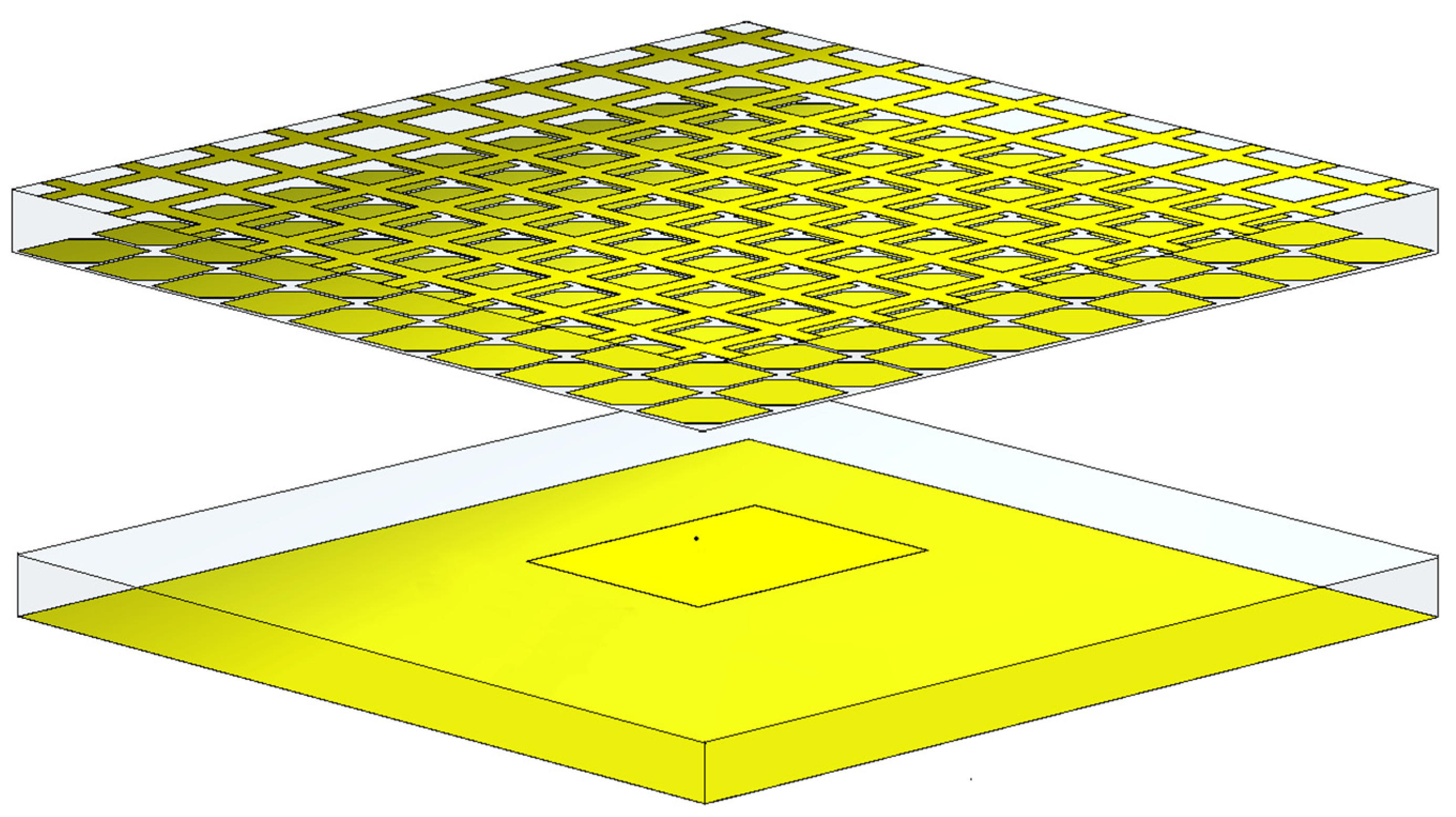
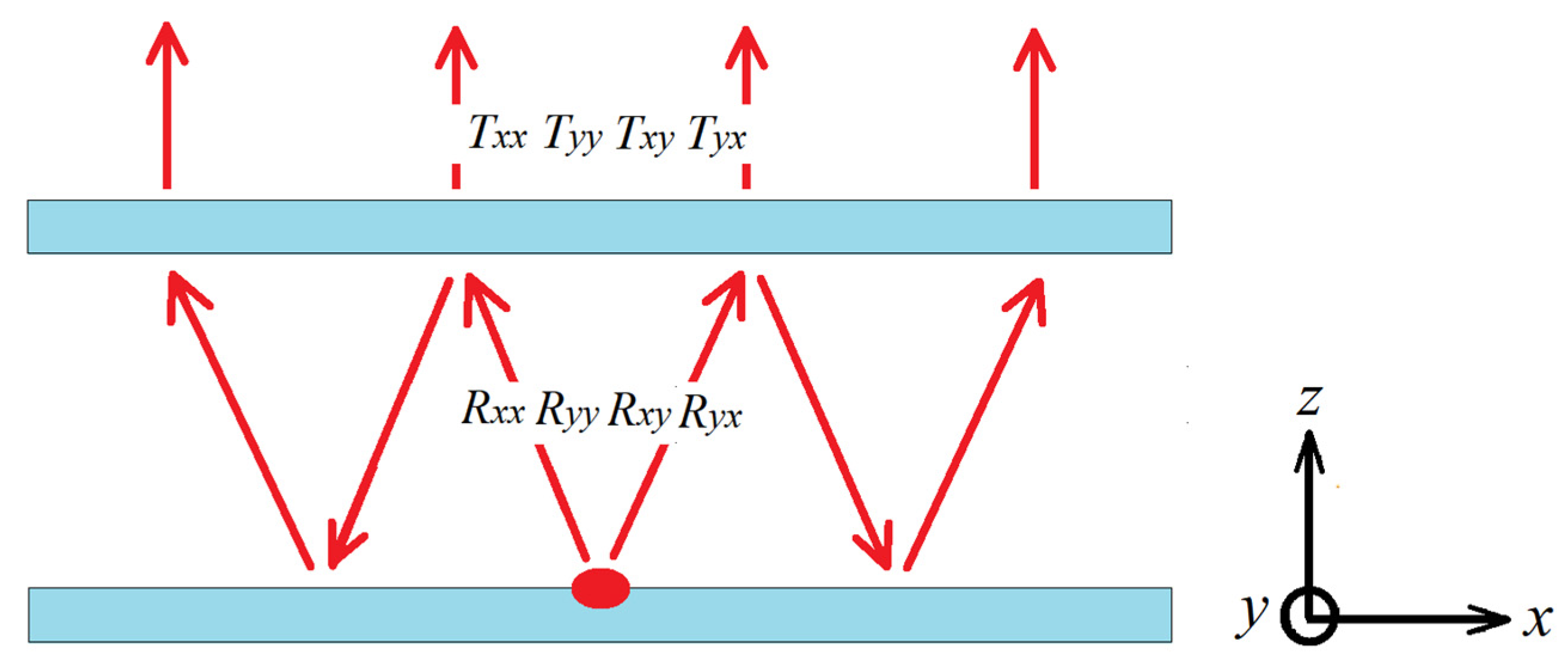
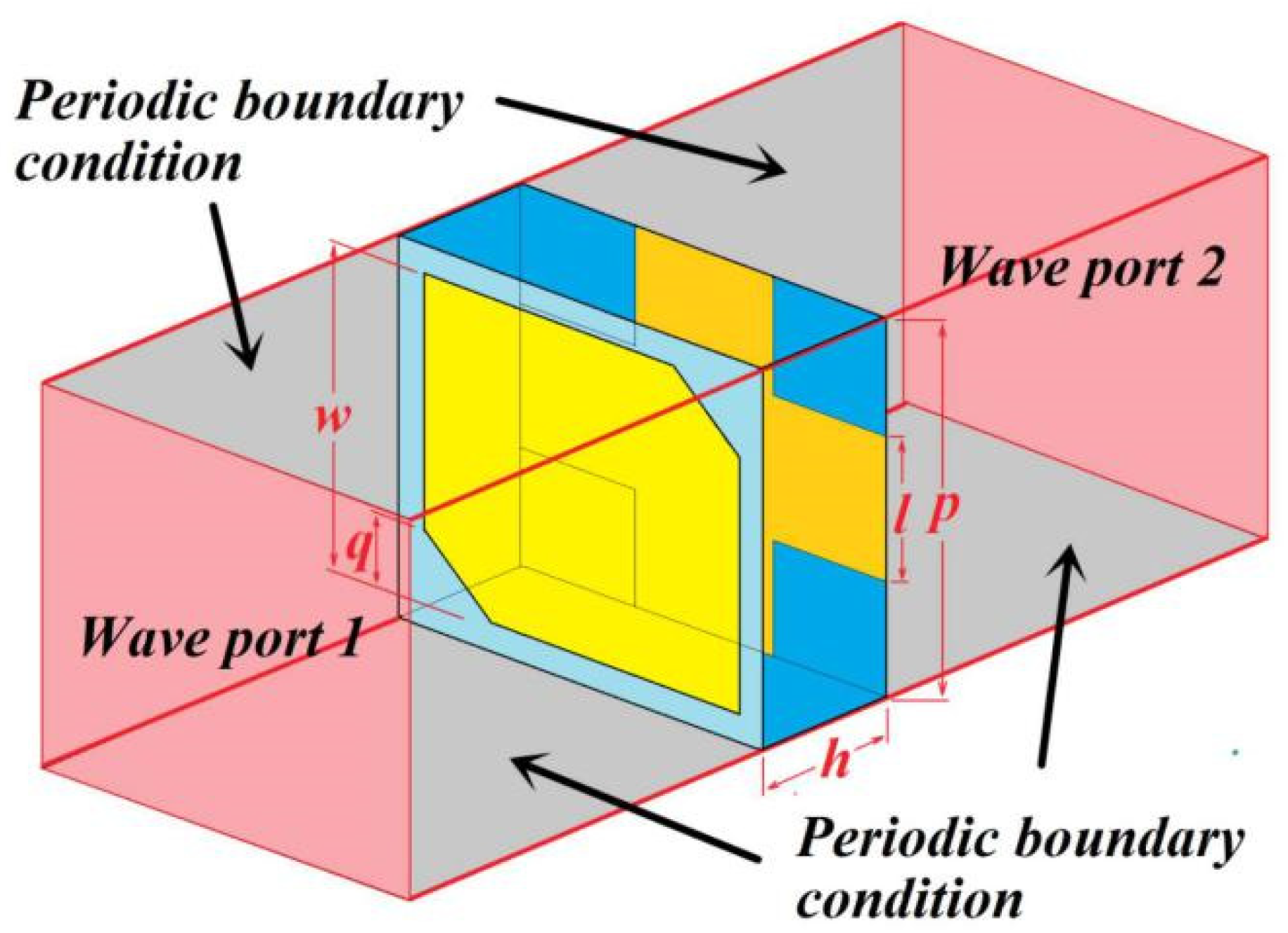
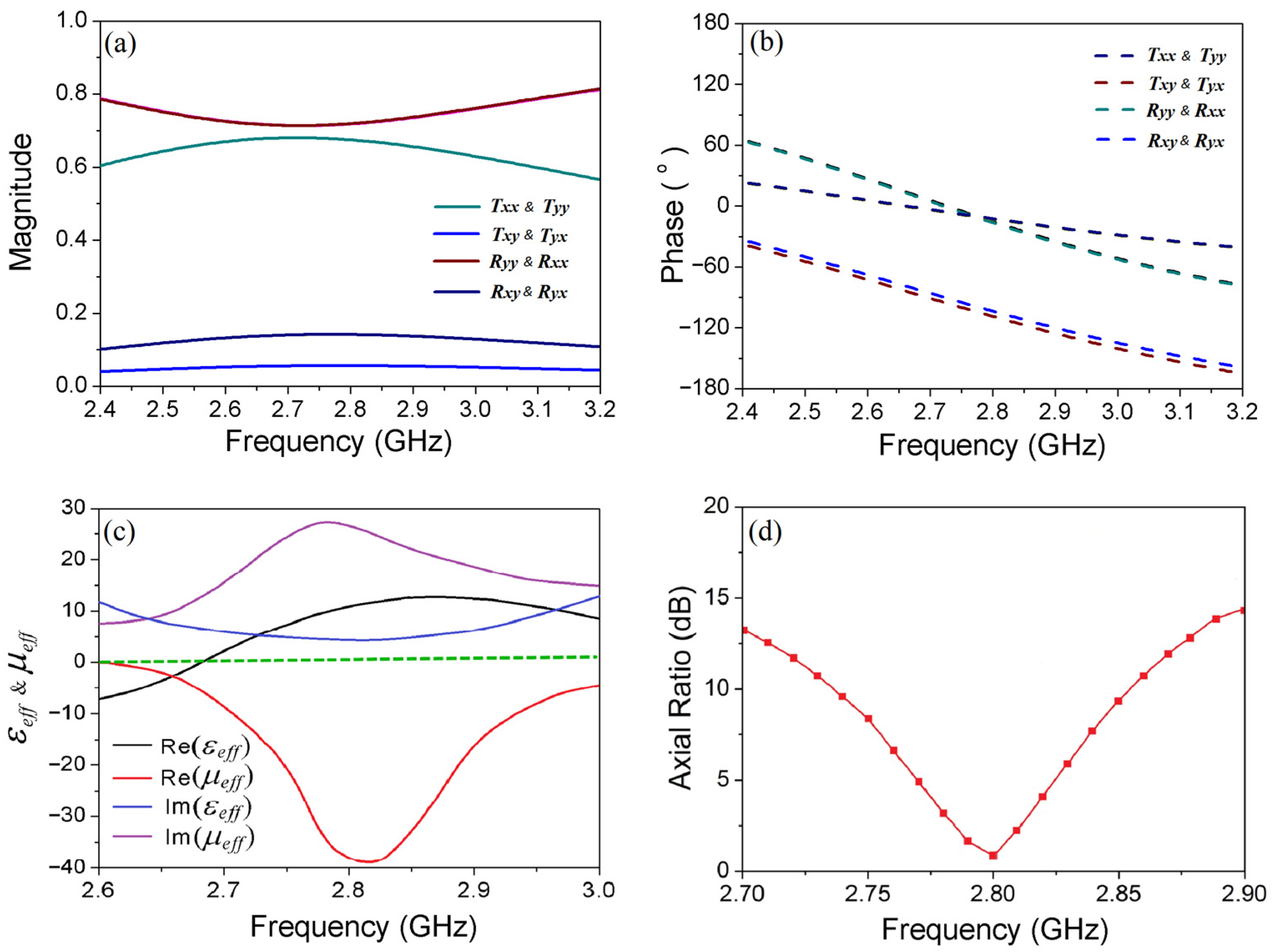

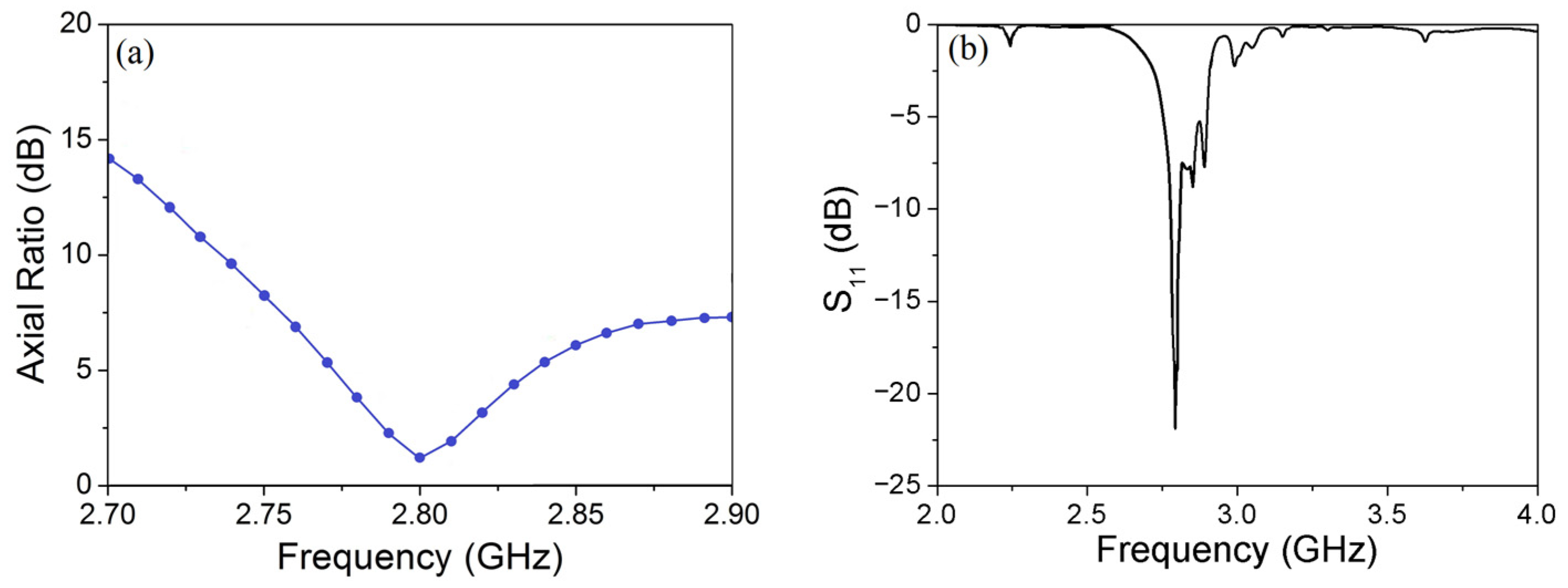
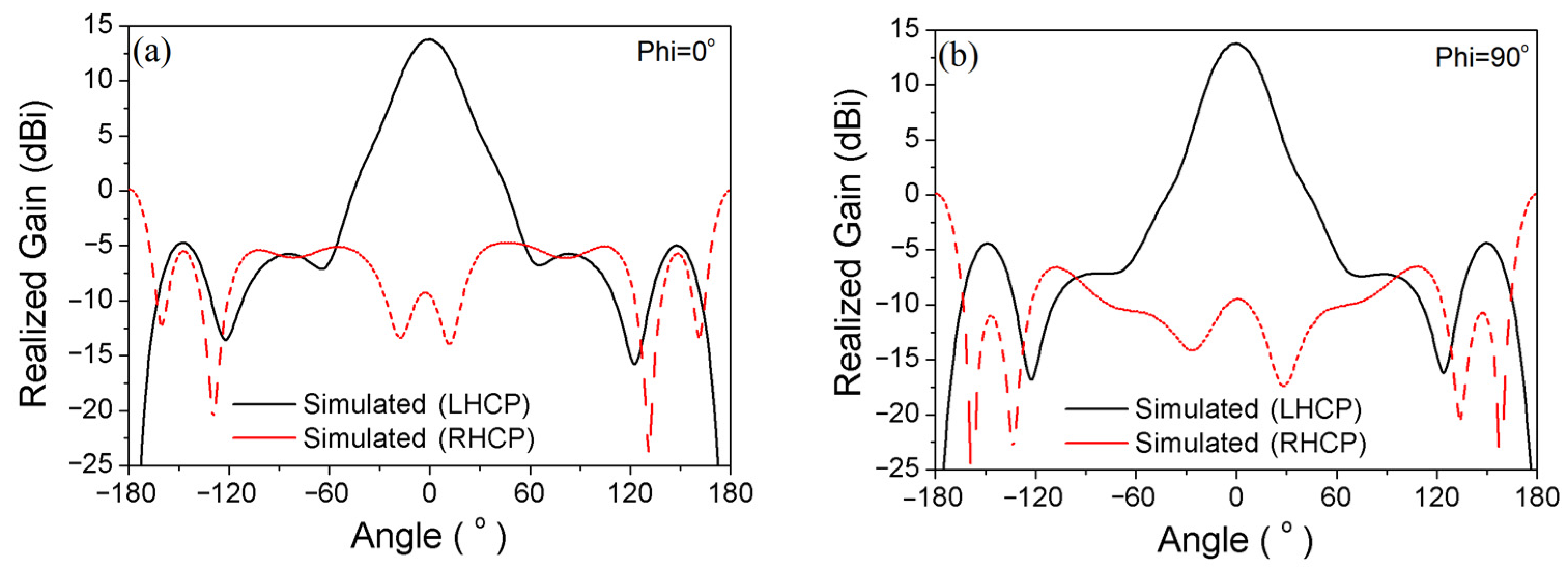

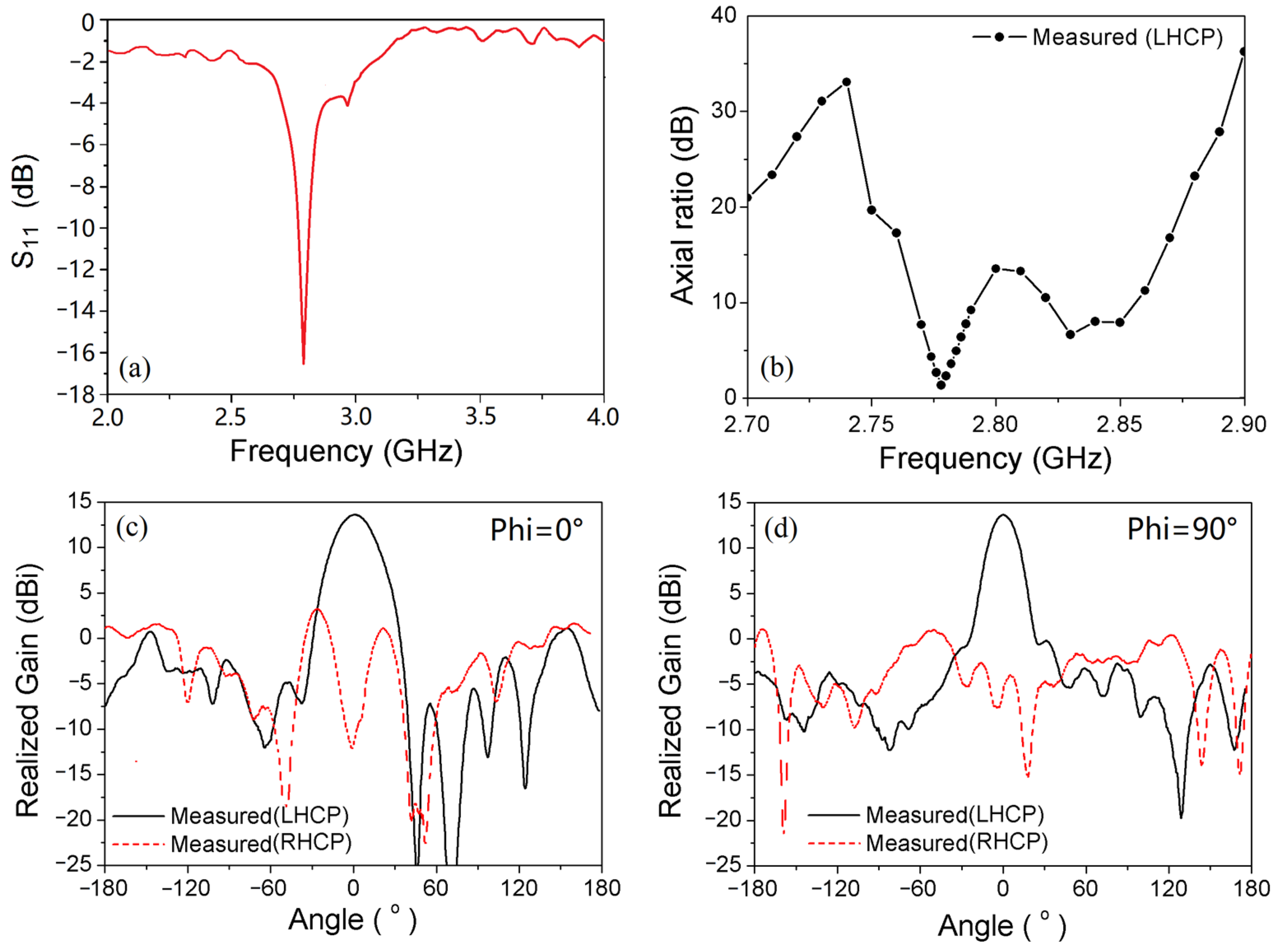

Disclaimer/Publisher’s Note: The statements, opinions and data contained in all publications are solely those of the individual author(s) and contributor(s) and not of MDPI and/or the editor(s). MDPI and/or the editor(s) disclaim responsibility for any injury to people or property resulting from any ideas, methods, instructions or products referred to in the content. |
© 2023 by the authors. Licensee MDPI, Basel, Switzerland. This article is an open access article distributed under the terms and conditions of the Creative Commons Attribution (CC BY) license (https://creativecommons.org/licenses/by/4.0/).
Share and Cite
Wang, W.; Lu, G.; Diao, C.; Li, J.; Liu, F.; Du, G. Subwavelength-Cavity High-Gain Circularly Polarized Antenna with Planar Metamaterials. Appl. Sci. 2023, 13, 7665. https://doi.org/10.3390/app13137665
Wang W, Lu G, Diao C, Li J, Liu F, Du G. Subwavelength-Cavity High-Gain Circularly Polarized Antenna with Planar Metamaterials. Applied Sciences. 2023; 13(13):7665. https://doi.org/10.3390/app13137665
Chicago/Turabian StyleWang, Wei, Guang Lu, Chao Diao, Junyang Li, Fen Liu, and Guiqiang Du. 2023. "Subwavelength-Cavity High-Gain Circularly Polarized Antenna with Planar Metamaterials" Applied Sciences 13, no. 13: 7665. https://doi.org/10.3390/app13137665
APA StyleWang, W., Lu, G., Diao, C., Li, J., Liu, F., & Du, G. (2023). Subwavelength-Cavity High-Gain Circularly Polarized Antenna with Planar Metamaterials. Applied Sciences, 13(13), 7665. https://doi.org/10.3390/app13137665






